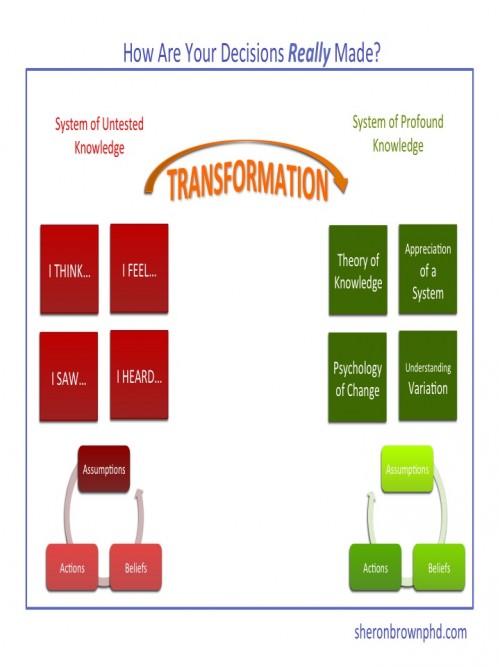“Can’t we just make all of our decisions based on our experiences?”
This was the question of an educational leader during a professional learning session on transformation. She was a huge advocate for data-driven decision making in her school system; however, I observed that the conflict between the leader’s espoused theory and theory in use was unconsciously demonstrated by the school leaders she supervised. While all of the school leaders I observed posted signs in the offices about data-driven decision making and their conversations were laden with the term, when they shared their decisions, they made statements such as “I think,” “I feel,” “I saw” or “I heard.”
To be clear,
When someone is asked how he would behave under certain circumstances, the answer he usually gives is his espoused theory of action for that situation. This is the theory of action to which he gives allegiance, and which, upon request, he communicates to others. However the theory that actually governs his actions is his theory-in-use, which may or may not be compatible with his espoused theory; furthermore, the individual may or may not be aware of incompatibility of the two theories (Argyris and Schön, 1974, pp. 6-7.)
With the Common Core upon us, it is critical that we maintain a reflective stance on a daily basis to ensure that our communicated theory is the actual one in use. We want to ensure that authentic transformation for student achievement occurs because of our data-based actions.
Last week I shared a tool that school leaders could use to self-assess their leadership team’s actual practices as they relate to authentic transformation. As you progress throughout the school year, you’ll want to ensure regular reflective practice, and so, today I present a new tool with a new challenge.
Consider this 7-day challenge:
- Document the percentage of your student-achievement related decisions that you believe are data-driven
- Reflect daily for 7 days on 3 decisions per day that had an impact on student achievement
- Write if the decisions were based on actual and tangible data, an idea you had, your feeling, something you saw elsewhere, or something you heard
- If the decision was driven by data, note the specific data
- If the decision was based on any of the other factors, note which factor
- Determine the percentage of decisions that were made in each category in #3 at the close of the week
- Document the percentage of your student-achievemnt related decisions that were actually driven by tangible data
After completing the 7 steps, answer this: are you at, above or below your predicted percentage? If at, perfect! Keep moving forward. If above, even better! Keep challenging yourself. But if you were below, then it may be time to adjust your practices to move toward authentic transformation.
Transformation toward the 21st century school requires that we do what we say and we accomplish this by challenging our own thinking. So consider this: challenge your own thinking.
Reference:
Argyris, C. & Schön, D. (1974). Theory in practice: Increasing professional effectiveness, San Francisco: Jossey-Bass.
